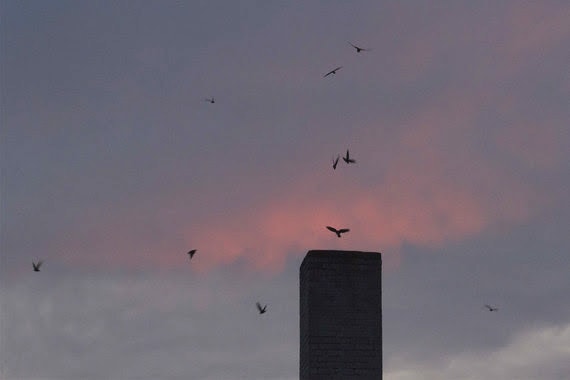Courtesy of the Wisconsin Department of Natural Resources
WISCONSIN – The Wisconsin Department of Natural Resources (DNR) is asking the public to report chimney swift sightings to help monitor populations and locate important roost sites before they begin their migration south.
The call to count is part of Swift Night Out (www.wiswifts.org/swift-night-out/), a continent-wide effort held to raise awareness about the decline of chimney swifts.
According to the Wisconsin Chimney Swift Working Group, after swifts have finished raising their young, they gather in groups at communal roosting chimneys before beginning their fall migration to South America. While migrating through Wisconsin from mid-April to early May, you can find large numbers of chimney swifts and hear their chittering sounds in the early evenings, ready to roost overnight in brick chimneys.
“Volunteers all over the state of Wisconsin have counted thousands and thousands of swifts roosting in chimneys over the past decade,” said Nancy Nabak, chair of the Wisconsin Chimney Swift Working Group. “It’s fascinating to watch, count and listen to swifts as they circle and whirl above chimneys before they roost for the night – it’s a visual sky concert.”
Although volunteers have counted large numbers of swifts since the program began, they’ve also documented the loss of many chimney swifts due to the demolition or capping of chimneys, resulting in a loss of habitat for this federally protected bird. The Wisconsin Chimney Swift Working Group hopes to bring attention to finding ways to protect existing chimneys, therefore protecting the chimney swift population.
Last year, the Wisconsin Chimney Swift Working Group partnered with the U.S. Fish & Wildlife Service to create a cost-share program to preserve swift chimneys in need of repair. Through the program, the Vernon County Historical Society successfully restored a chimney at the Vernon County Historical Museum in Viroqua, which hosts hundreds of swifts.
Those who know of a chimney that needs repair and currently hosts swifts are encouraged to contact the working group via email at [email protected].
Chimney swifts nest in eastern North America in the summer and migrate to South America in the fall, where they gather by the hundreds. Before European settlement, the birds nested in large hollow trees in old-growth forests. As these forests disappeared, the birds discovered brick chimneys as a replacement. Brick chimneys work well for the birds because they provide enclosed areas with a rough, vertical surface the birds can cling to, much like a hollow tree.
Unlike most birds, chimney swifts do not perch on branches but use the sharp nails on their tiny feet to cling to the sides of their roost.
According to the latest North American Breeding Bird Survey (www.on.doi.gov/3wwBwEy), the chimney swift population has declined by 72% in the past 50 years. Specific reasons for this loss are unknown, but pesticides, climate change and habitat loss likely all play a role.
Chimney swifts have slender bodies with long, curved wings and short, stubby tails (they look like a flying cigar or boomerang). They fly rapidly with nearly constant wing beats, often twisting from side to side. They also give a distinctive, high chittering call while in flight. They are the only bird that will drop into chimneys to roost for the night.
Here’s how you can help:
- Look for tall brick chimneys that are uncapped. If you find more than one chimney, do some scouting in the evenings to determine where the swifts will roost. Watch for swifts swooping over the chimney for a while before they enter. Be aware that the roost site choice can change from night to night, especially during migration.
- Pick one or more nights to monitor through September.
- Observe the roost starting roughly 20 minutes before sunset until 10 minutes after the last swift enters the chimney. Stay in one location, even if you do not see swifts right away. They may come to your site later, and you do not want to miss them. To be sure, stay 30 minutes after sunset to know if it was active or not. If you have zero swifts in your chimney, please record this because it is still valuable information.
- Count (or estimate) the number of swifts as they enter the chimney. It’s useful to count in groups of five or 10 when they enter quickly in large numbers. A handheld clicker counter can be helpful.
- Submit your data to www.eBird.org. Please note that a free www.eBird.org account is required to log in and submit your data. Map your roost site to an exact address or point when prompted for a location. After you enter the number of chimney swifts, use the hashtag #SwiftWI in the chimney swift details section, making your data submission easier to access.
- You can add additional information in the chimney swift details section, in this exact order, with semicolons separating the data: #SwiftWI; the type of building (residence, school, church, business, hospital, apartment, swift tower/structure, etc.); the condition of the chimney (in good shape, in need of repair); any other notes (example: #swiftwi; residence; chimney in need of repair; any other notes).
Find more information about chimney swifts and how to help protect them locally on the Wisconsin Chimney Swift Working Group website at www.wiswifts.org/.

